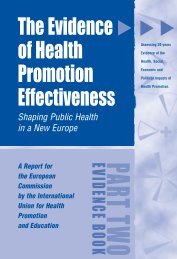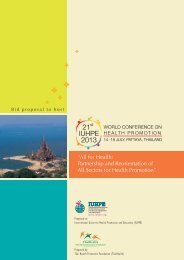Core Document - International Union for Health Promotion and ...
Core Document - International Union for Health Promotion and ...
Core Document - International Union for Health Promotion and ...
You also want an ePaper? Increase the reach of your titles
YUMPU automatically turns print PDFs into web optimized ePapers that Google loves.
Chapter Two<br />
Taking the <strong>Health</strong> <strong>Promotion</strong> Pulse<br />
Introducing the Evidence<br />
<strong>International</strong> experts from a variety of health promotion disciplines were invited<br />
to examine the literature <strong>and</strong> published research documentation of numerous<br />
interventions across the world. They were not asked to conduct new research. Their<br />
job was to analyse, critically, <strong>and</strong> within the boundaries of scientific tolerance, what<br />
had worked <strong>and</strong> what had not.<br />
They were then asked to tread new ground. In order to build a bridge between the<br />
health promotion discipline <strong>and</strong> the political community, our panel of international<br />
professors, academics <strong>and</strong> acknowledged world-leaders in health promotion practice<br />
were then asked to <strong>for</strong>mulate a series of Impact Assessments. In their view, as experts,<br />
what health, social, economic <strong>and</strong> political impacts did the interventions under<br />
consideration achieve? � These impacts are analysed in Chapter Three of this Part; each chapter in<br />
the Evidence Book carries subject-specific assessments.<br />
Traditionally, health promotion interventions have either been targeted within<br />
defined settings (such as schools, workplaces, cities) or with identified population<br />
groups (such as elderly people or youth). Inevitably, programmes <strong>and</strong> strategies cross<br />
boundaries. In order to best illuminate <strong>and</strong> demonstrate the work of various<br />
strategies, we decided to report on topics of political relevance as well as healthcare<br />
<strong>and</strong> social relevance. Some are settings-based; others are populations-based; still<br />
others straddle both. The report, especially the Evidence Book in Part Two, is not<br />
designed as a comprehensive best-practice manual, but it is designed to be a rounded<br />
analysis of health promotion effectiveness, demonstrating where <strong>and</strong> how it is<br />
relevant to decision makers.<br />
We there<strong>for</strong>e asked our research team to look at the major political challenges in<br />
the New Europe: ageing, mental health, <strong>and</strong> the challenge of coping with<br />
disenfranchised groups such as out-of-school youth. We asked others to look at major<br />
health issues, such as heart health <strong>and</strong> the impact of tobacco, alcohol <strong>and</strong> illicit drug<br />
use. We researched areas where health promotion has gained high public profiles,<br />
such as nutrition <strong>and</strong> safety issues. We examined two key settings where health<br />
promotion activity has a particularly important social <strong>and</strong> economic impact – in the<br />
workplace, <strong>and</strong> in schools. We asked <strong>for</strong> a case history on oral health, an often<br />
neglected issue in many countries, but one where major health gains have been made.<br />
And we asked about health promotion in the health care sector itself: what role can<br />
doctors, nurses <strong>and</strong> other health sector practitioners play in promoting better health.<br />
Finally, we looked at the heated issue of Equity. Put simply, the health of lower<br />
economic <strong>and</strong> social groups is significantly poorer than higher groups, right across<br />
Europe. With poverty comes disease. And with poor education, poor housing, poor<br />
family stability comes violence, substance abuse, mental illness, heart disease <strong>and</strong><br />
increased morbidity <strong>and</strong> mortality. The evidence shows that inequity in social <strong>and</strong><br />
Taking the <strong>Health</strong> <strong>Promotion</strong> Pulse<br />
9






